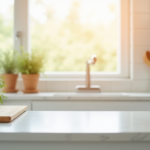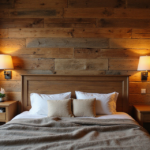Picture stepping into a kitchen where weathered wood meets crisp white cabinets, where vintage finds tell stories of generations past, and where every detail whispers of simpler times. The farmhouse kitchen has captured hearts precisely because it marries timeless beauty with lived-in comfort, creating spaces that feel both elegant and effortlessly welcoming.
The secret to achieving this coveted aesthetic lies not in expensive renovations, but in the thoughtful curation of farmhouse kitchen decorations that layer texture, history, and personality throughout the space. From the foundational elements like color palettes and architectural details to the finishing touches of vintage treasures and fresh greenery, each piece contributes to a cohesive story of warmth and authenticity.
Whether you’re starting fresh or refreshing your existing kitchen, these 20 essential farmhouse kitchen decorations will guide you toward creating a space that feels both beautifully designed and genuinely lived-in – the kind of kitchen where memories are made and traditions are born.
1. Master the Classic White & Neutral Color Palette
The foundation of every successful farmhouse kitchen begins with a serene palette of whites, creams, and soft grays that creates an instantly calming atmosphere. This isn’t merely about following trends – it’s about crafting a backdrop that makes your space feel larger, brighter, and more welcoming while providing the perfect canvas for layering textures and personal touches.
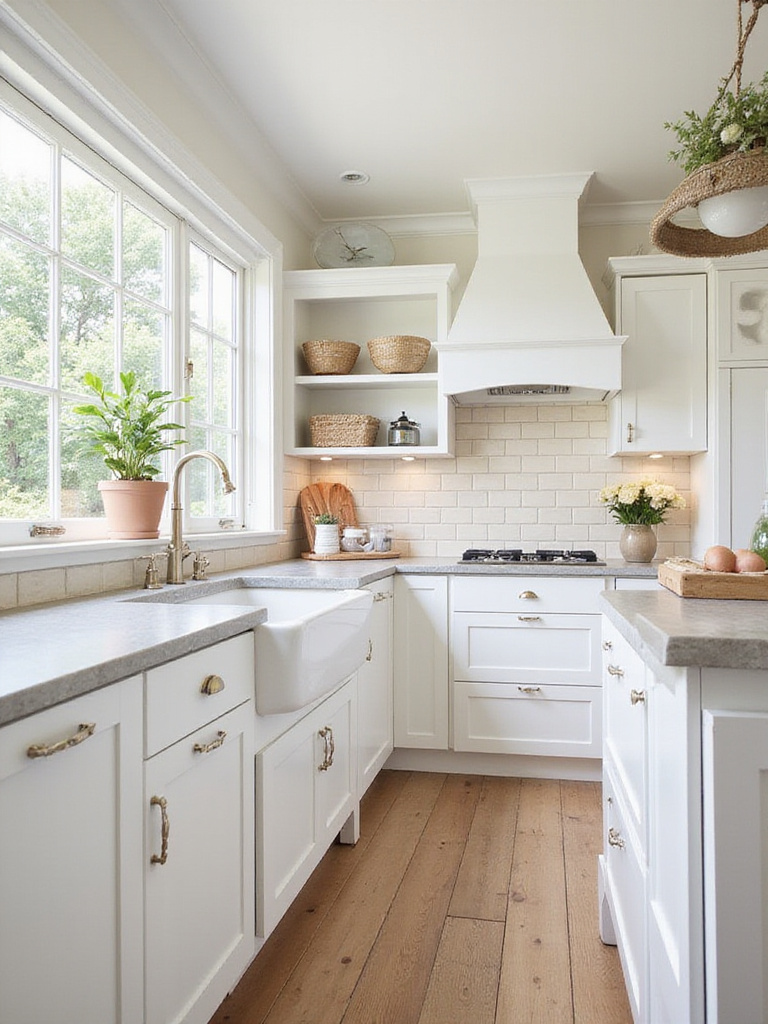
When you embrace this classic approach, you’re investing in longevity that transcends fleeting design fads. The beauty of neutral farmhouse kitchen decorations lies in their ability to adapt and evolve with your changing tastes, allowing you to refresh seasonal accents or incorporate new finds without requiring major overhauls. Consider layering different shades of white – perhaps crisp white cabinets paired with creamy subway tiles and warm ivory walls – to create depth without overwhelming the senses.
- Paint Selection Tips: Test multiple white samples in different lighting conditions, as undertones can shift dramatically from morning to evening
- Layering Strategy: Combine warm and cool neutrals through different materials like painted wood, natural stone, and woven textiles
- Accent Opportunities: Use this neutral foundation to highlight natural wood tones, vintage metals, and seasonal greenery
Look closely and you’ll notice the subtle texture of this neutral foundation creates the perfect stage for introducing architectural character.
2. Install a Shiplap Accent Wall for Instant Character
Nothing transforms a plain kitchen wall quite like the distinctive horizontal lines of shiplap, which instantly infuses your space with that coveted farmhouse authenticity. This architectural detail creates visual movement and depth while serving as a stunning backdrop for open shelving, artwork, or simply standing alone as a statement feature that draws the eye and anchors the room’s design.
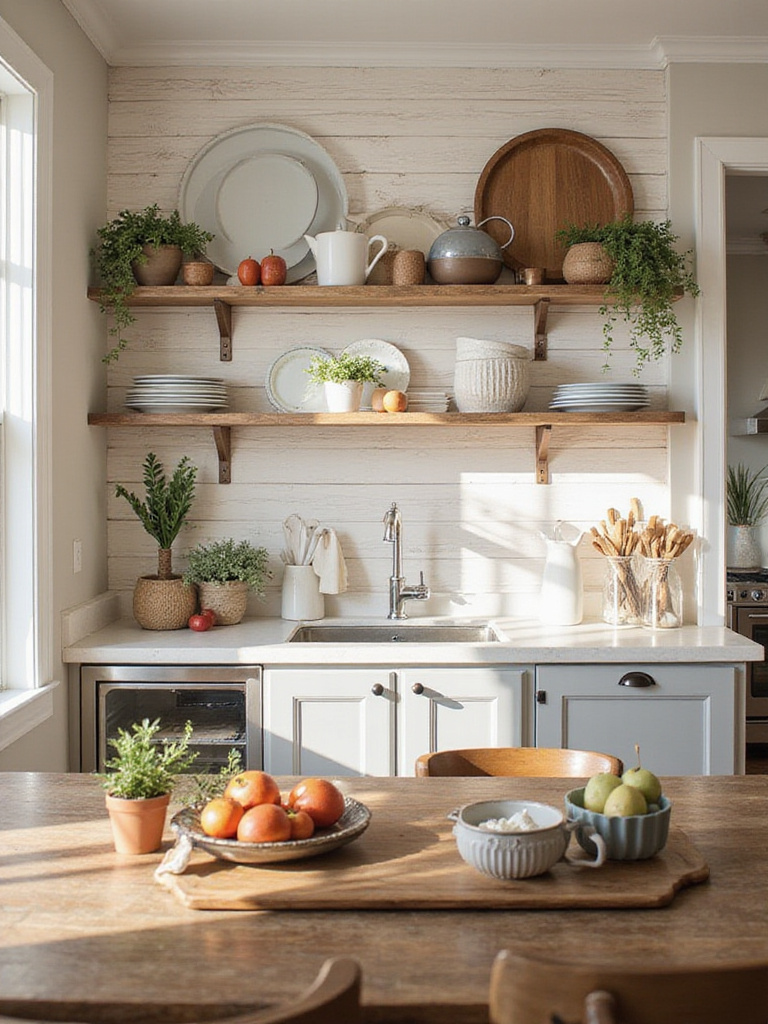
The magic of shiplap lies in its versatility – whether you choose traditional white-painted boards for a bright, coastal feel or opt for natural wood tones that add warmth and texture. Installation has become increasingly accessible with pre-finished options that dramatically reduce project time, making this one of the most impactful farmhouse kitchen decorations you can add. Consider applying shiplap to a single accent wall behind your range or sink area to create a focal point without overwhelming the space.
Beyond aesthetics, shiplap offers practical benefits in kitchen environments when properly sealed, providing a durable surface that’s easier to clean than textured wallpaper while adding subtle sound absorption that makes conversations more intimate and comfortable.
The designer’s secret here is to pair shiplap with complementary textures that create visual dialogue throughout the space.
3. Add Open Shelving to Display Rustic Treasures
Replacing upper cabinets with open shelving creates an immediate sense of spaciousness while providing the perfect platform to showcase your carefully curated collection of farmhouse kitchen decorations. This design choice transforms storage into display, allowing your everyday dishes, vintage finds, and decorative objects to become integral parts of the room’s aesthetic story.
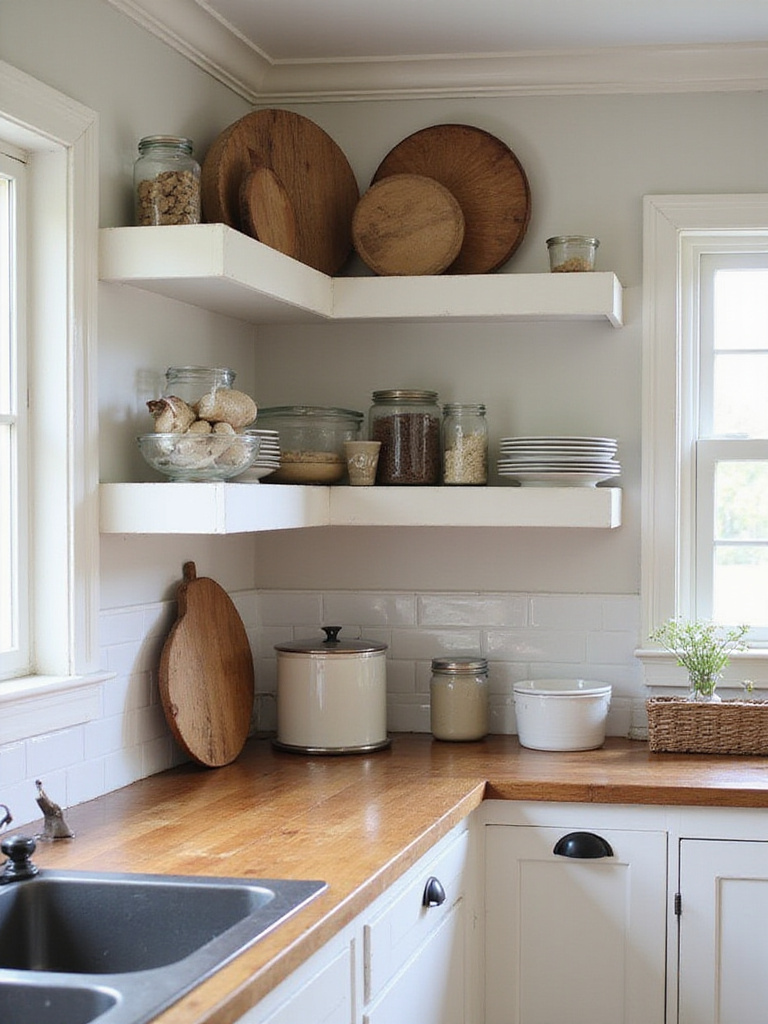
The key to successful open shelving lies in thoughtful curation – mixing functional pieces like stoneware bowls and wooden cutting boards with decorative elements such as vintage pitchers or small potted herbs. This approach creates visual rhythm through repetition of colors, materials, and shapes while maintaining the lived-in authenticity that defines farmhouse style.
When planning your shelving arrangement, consider these essential elements:
- Scale Variation: Combine large statement pieces with smaller grouped items to create visual balance
- Material Harmony: Echo materials used elsewhere in the kitchen, such as matching wood tones or metal finishes
- Functional Beauty: Display items you actually use, allowing natural wear and patina to enhance authenticity over time
What makes this design special is the way it encourages you to live with and appreciate beautiful objects daily rather than hiding them away.
4. Upgrade to a Classic Apron Sink for Timeless Appeal
The farmhouse sink, with its distinctive exposed front panel and generous basin, serves as both a functional workhorse and a stunning centerpiece that immediately establishes your kitchen’s character. This iconic fixture transforms the humble act of washing dishes into a more pleasant experience while creating a focal point that draws visitors and family members to gather around.

Beyond its undeniable visual impact, an apron sink offers superior functionality for busy kitchens. The deep, wide basin easily accommodates oversized pots, baking sheets, and holiday platters that struggle to fit in standard sinks, while the forward-positioned design reduces back strain during extended use. Whether you choose classic white fireclay for timeless elegance or opt for stainless steel for a more contemporary farmhouse feel, this upgrade significantly enhances both daily function and long-term home value.
The craftsmanship in this fixture tells a story of enduring quality that perfectly embodies farmhouse values of durability and honest beauty. Professional installation ensures proper support for the sink’s substantial weight while creating the seamless integration that makes this element appear original to the home.
Running your hand across this material reveals the substantial quality that separates authentic farmhouse kitchen decorations from their mass-produced counterparts.
5. Choose Pendant Lighting to Create Warm Ambiance
Strategic pendant lighting brings both practical illumination and sculptural beauty to your farmhouse kitchen, creating pools of warm light that define specific zones while adding vertical interest and personality. These suspended fixtures serve as jewelry for your space, offering opportunities to introduce materials like aged metals, seeded glass, or woven natural fibers that reinforce the authentic farmhouse aesthetic.
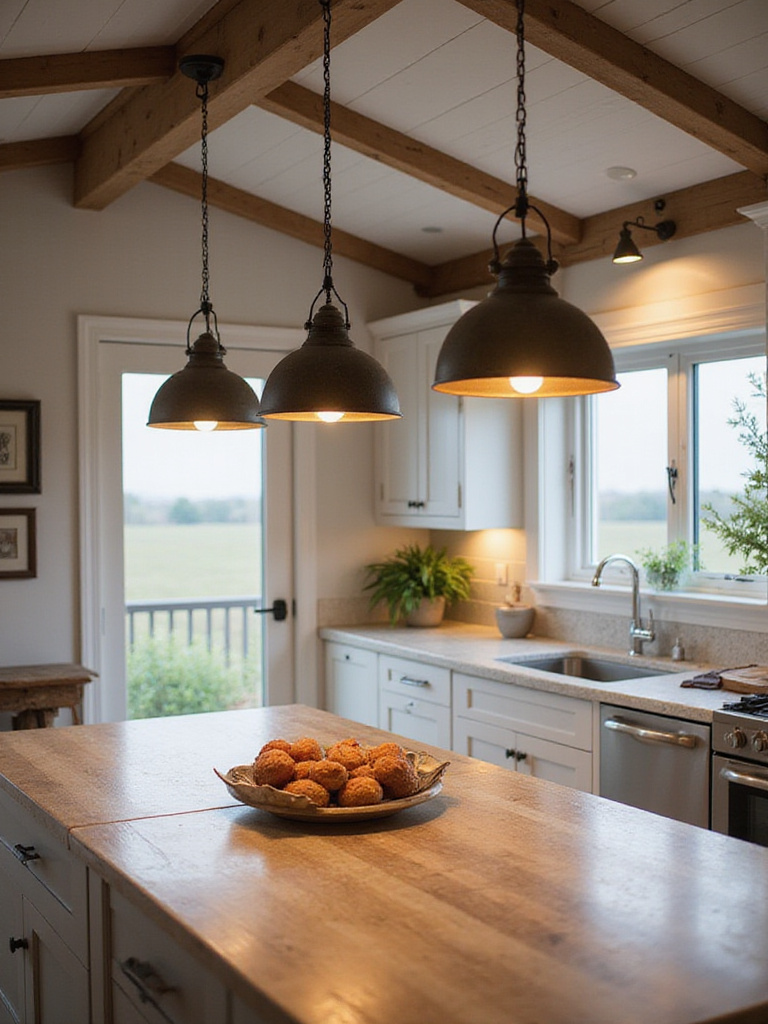
The positioning of pendant lights over islands, sinks, or dining areas creates intimate gathering spots within the larger kitchen space while providing focused task lighting where it’s needed most. Consider the scale and proportion carefully – oversized fixtures make bold statements in kitchens with high ceilings, while smaller grouped pendants create rhythmic visual interest over long islands or breakfast bars.
When selecting farmhouse kitchen decorations for lighting, prioritize fixtures that tell a story through their materials and craftsmanship. Vintage-inspired designs with Edison bulbs, barn-style metal shades, or hand-blown glass globes each contribute different moods while maintaining the authentic character essential to the style.
The interplay between the colors creates a foundation for introducing natural warmth through your next surface selection.
6. Opt for Warm Butcher Block Countertops
Butcher block countertops bring irreplaceable warmth and natural beauty to farmhouse kitchens, creating surfaces that invite touch and develop character through daily use. Unlike cold stone alternatives, wood counters provide a living material that ages gracefully, developing a rich patina that tells the story of countless family meals and gathered moments.

The practical benefits extend far beyond aesthetics – wood surfaces are naturally antibacterial when properly maintained, gentler on knives than stone, and can be sanded and refinished to look new again after years of service. This repairability makes butcher block an investment that improves with age rather than showing wear, embodying the farmhouse principle of lasting quality over disposable convenience.
Different wood species offer varied characteristics for your farmhouse kitchen decorations:
- Maple: Light, tight grain with excellent durability for high-use areas
- Oak: Classic choice with prominent grain patterns that hide minor scratches
- Walnut: Rich chocolate tones that create stunning contrast with white cabinetry
The sustainable journey of this material involves responsible forestry practices that align with farmhouse values of environmental stewardship and connection to the land.
7. Select Wide Plank Wood Flooring for Authentic Foundation
Wide plank flooring creates the expansive, uncluttered foundation essential to authentic farmhouse design, with boards typically 5 inches or wider that minimize visual interruption and showcase the natural beauty of wood grain. This choice immediately establishes the room’s character while providing a durable surface that can withstand decades of family life and multiple refinishing cycles.
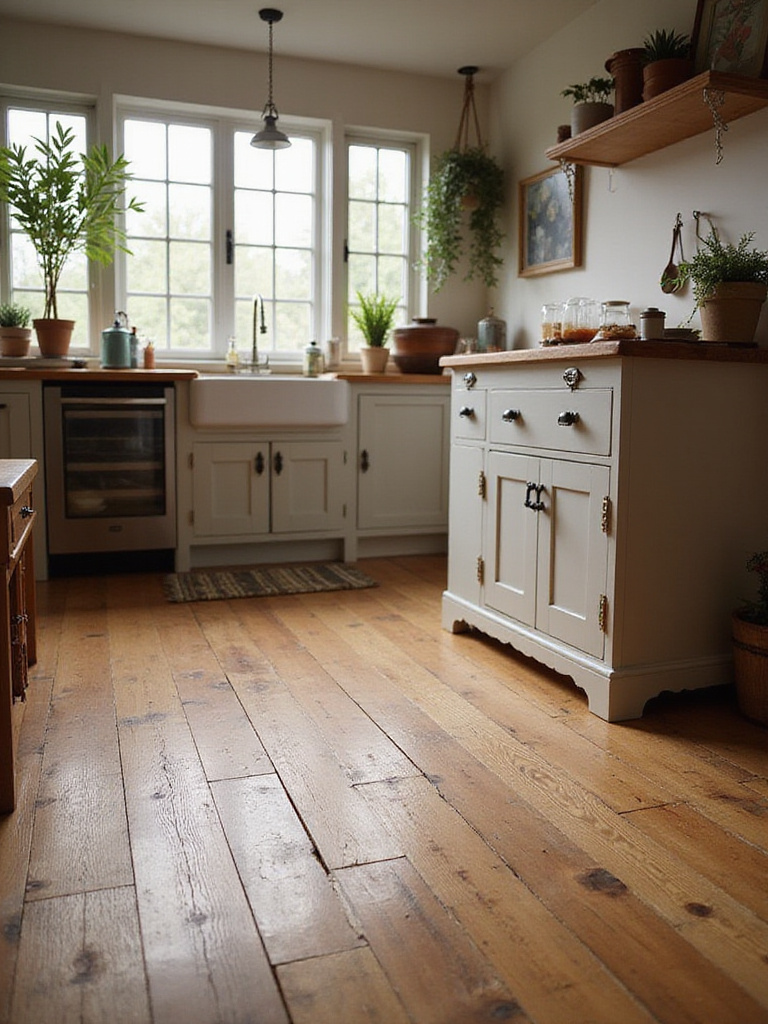
The visual impact of fewer seam lines creates a sense of spaciousness that particularly benefits smaller kitchens, while the substantial feel underfoot conveys quality and permanence. When selecting farmhouse kitchen decorations for flooring, consider how different wood species and finishes will interact with your lighting and cabinet choices – lighter woods like white oak brighten spaces, while reclaimed barn wood adds instant history and character.
Proper installation and finishing ensure your investment will reward you with lasting beauty. Choose finishes specifically designed for kitchen environments that resist moisture and daily wear while allowing the wood’s natural character to shine through. The patina that develops over time becomes part of the floor’s story, creating the authentic lived-in quality that defines farmhouse style.
Unlike mass-produced alternatives, this technique allows each plank to display unique grain patterns that make your kitchen truly one-of-a-kind.
8. Incorporate a Sturdy Farmhouse Dining Table
A substantial farmhouse dining table serves as the gravitational center of your kitchen, creating a gathering place that embodies the style’s emphasis on family, community, and shared meals. Whether positioned within the kitchen itself or in an adjacent dining area, this piece anchors the space while providing a durable surface for everything from daily homework sessions to holiday feasts.
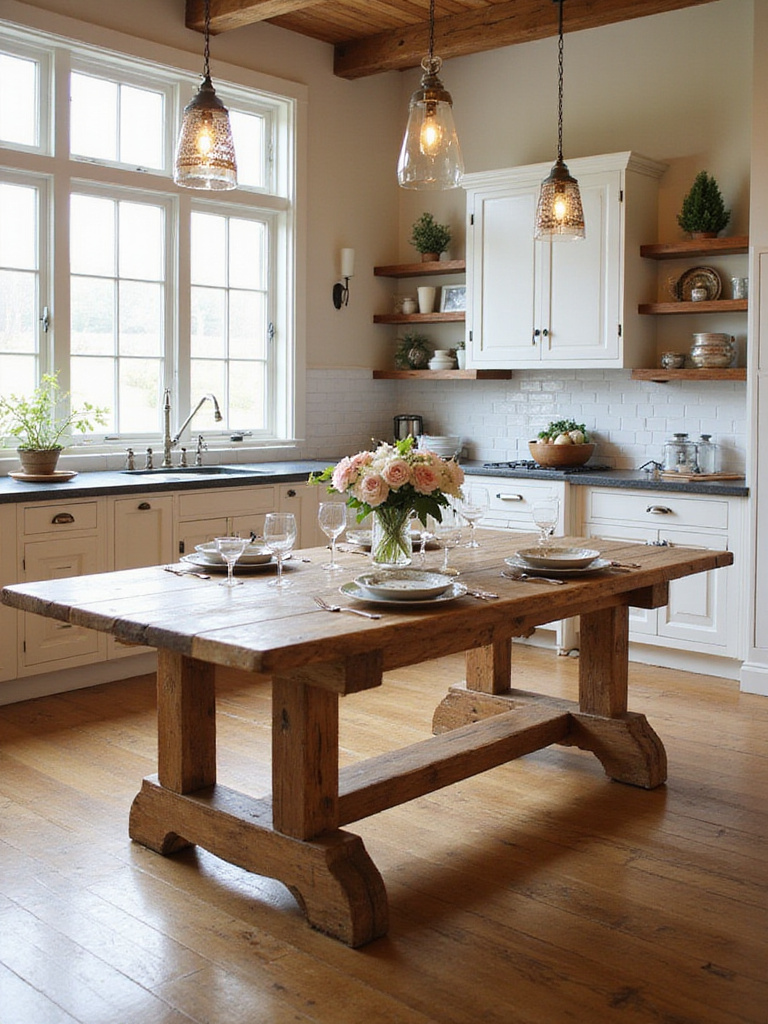
The construction quality of a true farmhouse table reflects values of craftsmanship and longevity – solid wood construction, traditional joinery techniques, and finishes that improve with age rather than showing wear. These pieces often become family heirlooms, developing character through generations of use while maintaining their structural integrity and beauty.
Consider these factors when selecting your table:
- Size Proportions: Allow at least 3 feet of clearance around the table for comfortable movement
- Wood Species: Choose hardwoods like oak or maple for durability, or pine for authentic rustic character
- Finish Options: Distressed surfaces hide daily wear, while natural finishes showcase wood beauty
The artisans behind these designs began with traditional techniques that create furniture built to last generations rather than years.
9. Update Cabinets with Vintage-Style Hardware
Cabinet hardware functions as the jewelry of your kitchen, and selecting vintage-inspired pieces instantly transforms the character of your space without the expense of cabinet replacement. These small details create significant visual impact while providing daily tactile experiences that reinforce the authentic farmhouse aesthetic through materials like oil-rubbed bronze, antique brass, or matte black finishes.
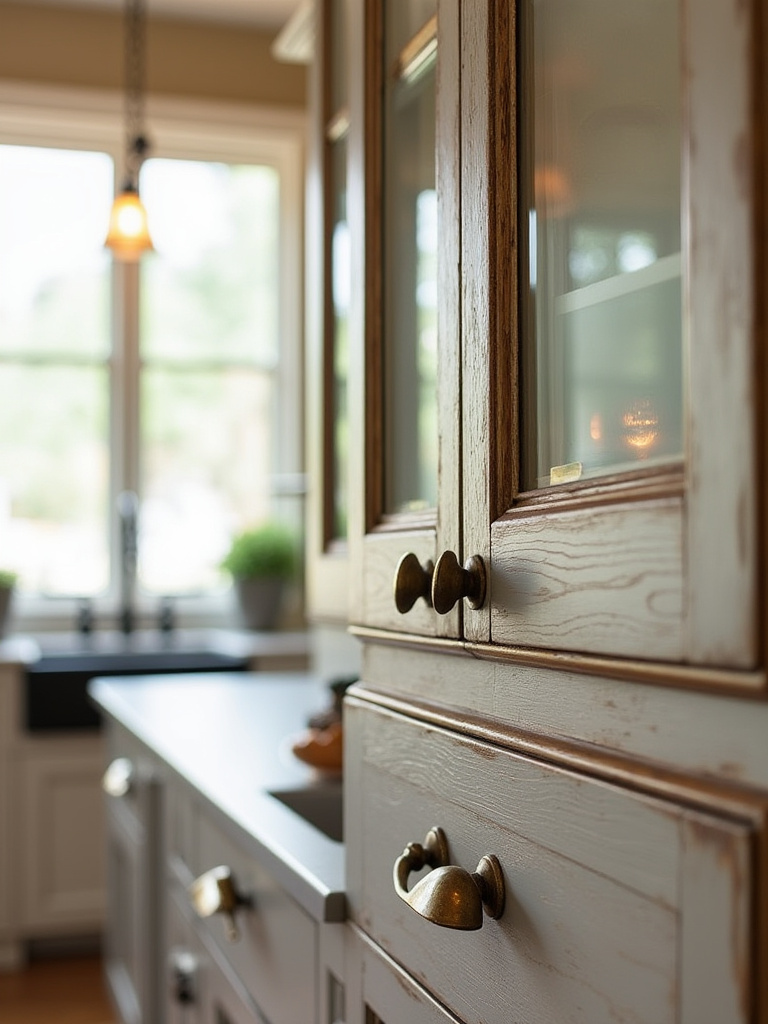
The beauty of hardware updates lies in their immediate transformation power – swapping generic pulls for cup pulls, bin pulls, or vintage-style knobs can shift your kitchen’s entire personality in an afternoon. This approach allows you to test new styles and finishes affordably while creating the layered, collected-over-time look that defines authentic farmhouse kitchen decorations.
Mix different hardware styles for genuine vintage appeal – use cup pulls on drawers and round knobs on doors, or combine different finishes within the same family for subtle variation that mimics the way real farmhouse kitchens evolved over time. The key is maintaining consistency in overall style while allowing for the slight imperfections that make spaces feel human and lived-in.
The traditional methods used result in hardware that feels substantial in your hand and operates smoothly for years of daily use.
10. Install a Simple Subway Tile Backsplash
Classic subway tile provides the perfect backdrop for farmhouse kitchen decorations, offering timeless appeal that never competes with other design elements while providing essential protection for walls behind sinks and cooktops. This versatile foundation allows other textures and materials to shine while contributing its own subtle pattern and clean lines to the overall composition.
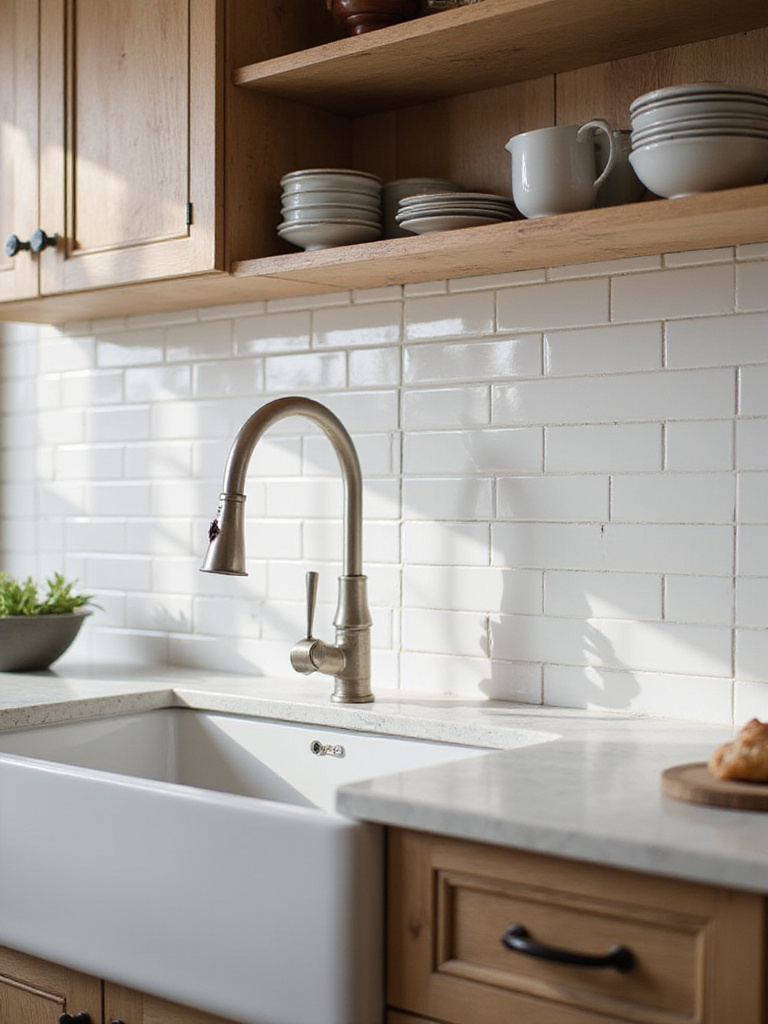
The enduring popularity of subway tile stems from its ability to work with virtually any design approach within the farmhouse style – from crisp white tiles with bright grout for a fresh, modern farmhouse look to handmade tiles with subtle variations and darker grout for more rustic character. The installation pattern also offers creative opportunities, with traditional running bond, herringbone, or vertical stack patterns each creating different visual effects.
When selecting your tile, consider the subtle differences that create authentic character – handmade tiles with slight size variations, beveled edges that catch light, or slightly off-white tones that add warmth. These details prevent the sterile appearance of perfectly uniform tiles while maintaining the clean simplicity essential to farmhouse style.
Beyond aesthetics, the ecological impact matters because ceramic tiles are made from abundant natural materials and can last for decades with minimal maintenance.
11. Layer Natural Wood Tones for Depth
Creating visual richness through varied wood tones prevents your farmhouse kitchen from feeling flat or monotonous, instead building the layered, collected-over-time aesthetic that defines authentic farmhouse style. This technique involves thoughtfully combining different wood species, finishes, and textures throughout the space to create depth and visual interest.

The secret lies in balancing contrast with harmony – pairing light oak cabinets with a darker walnut island top, or combining smooth maple counters with rough-hewn reclaimed wood shelving. These variations create focal points and define different areas within the kitchen while maintaining overall cohesion through careful attention to undertones and proportions.
Successful wood layering incorporates these elements:
- Scale Variation: Large surfaces like flooring, medium elements like furniture, and small accents like cutting boards
- Texture Contrast: Smooth painted surfaces balanced with natural grain and distressed finishes
- Tonal Range: Light, medium, and dark woods distributed throughout the space for visual balance
The heritage technique gets a contemporary update through modern finishing methods that enhance durability while preserving authentic character.
12. Introduce Galvanized Metal Accents
Galvanized metal brings authentic industrial heritage to farmhouse kitchens through its distinctive matte gray finish and honest, utilitarian character. These accents provide essential cool-toned contrast to warm wood and soft textiles while adding the kind of practical beauty that defines farmhouse kitchen decorations – pieces that are both functional and visually appealing.

The patina of galvanized metal tells stories of honest work and practical use, making it perfect for items like pendant lights, storage containers, or decorative trays that serve dual purposes. Unlike shiny metals that demand attention, galvanized finishes provide subtle texture and visual interest that supports rather than competes with other design elements.
Incorporate galvanized pieces gradually, starting with smaller items like planters for herbs, storage bins for pantry organization, or vintage-inspired light fixtures. The key is achieving balance – enough metal to create visual interest without overwhelming the space with industrial elements that might feel cold or unwelcoming.
The sustainable innovation narrative includes galvanized steel’s longevity and recyclability, making it an environmentally conscious choice for farmhouse kitchen decorations.
13. Display Practical Kitchenware as Art
Transforming everyday kitchen tools into decorative elements creates the authentic, lived-in atmosphere that distinguishes true farmhouse style from staged perfection. This approach celebrates the beauty of functional objects while keeping essential tools within easy reach, embodying the farmhouse principle that beauty and utility should coexist seamlessly.
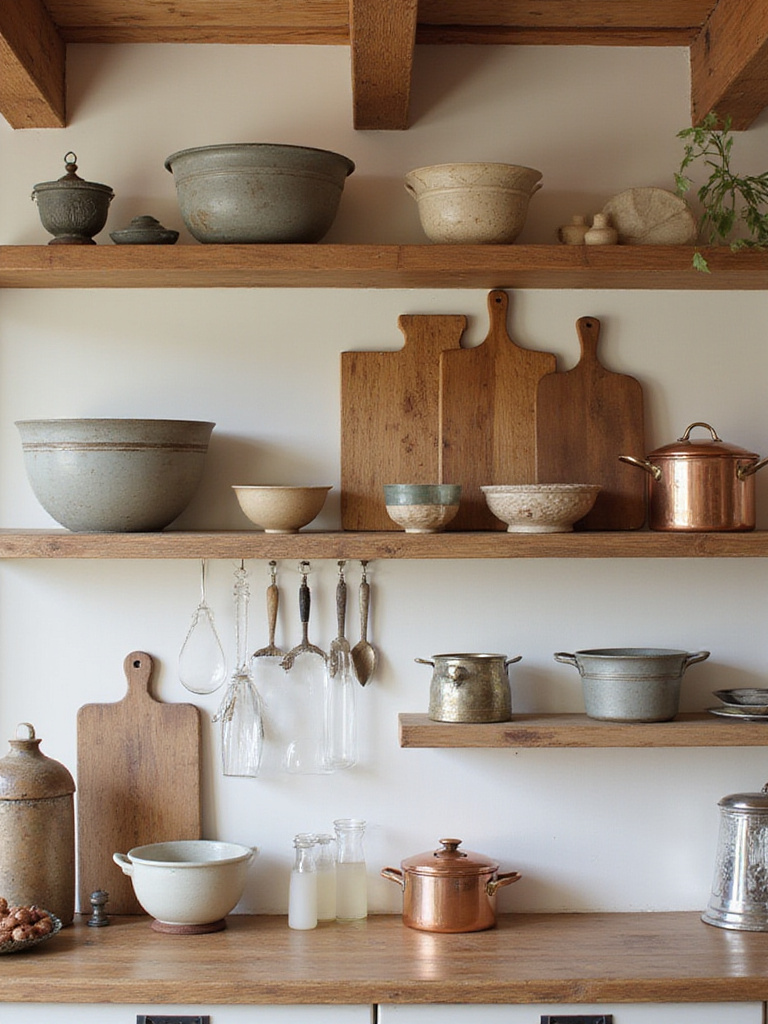
Wooden cutting boards leaned against backsplashes, copper pots hanging from ceiling racks, and vintage mixing bowls stacked on open shelves all contribute to this aesthetic while serving practical purposes. The key is selecting items that are genuinely beautiful and well-maintained, creating displays that feel intentional rather than cluttered.
Consider these display strategies for farmhouse kitchen decorations:
- Material Groupings: Cluster items by material – all copper, all wood, or all ceramic – for visual cohesion
- Functional Zones: Display items near where they’re used – cutting boards by prep areas, pots near the stove
- Seasonal Rotation: Change displayed items periodically to prevent visual staleness while highlighting different collections
The composition comes together when you balance everyday necessities with special pieces that reflect your personal style and cooking preferences.
14. Hunt for Authentic Vintage Kitchen Finds
Genuine vintage pieces bring irreplaceable soul and history to farmhouse kitchens, offering the kind of character and patina that simply cannot be manufactured. These treasures – from weathered cutting boards and enamelware to vintage scales and ceramic crocks – tell stories of previous owners while adding layers of authenticity that make your space truly unique.
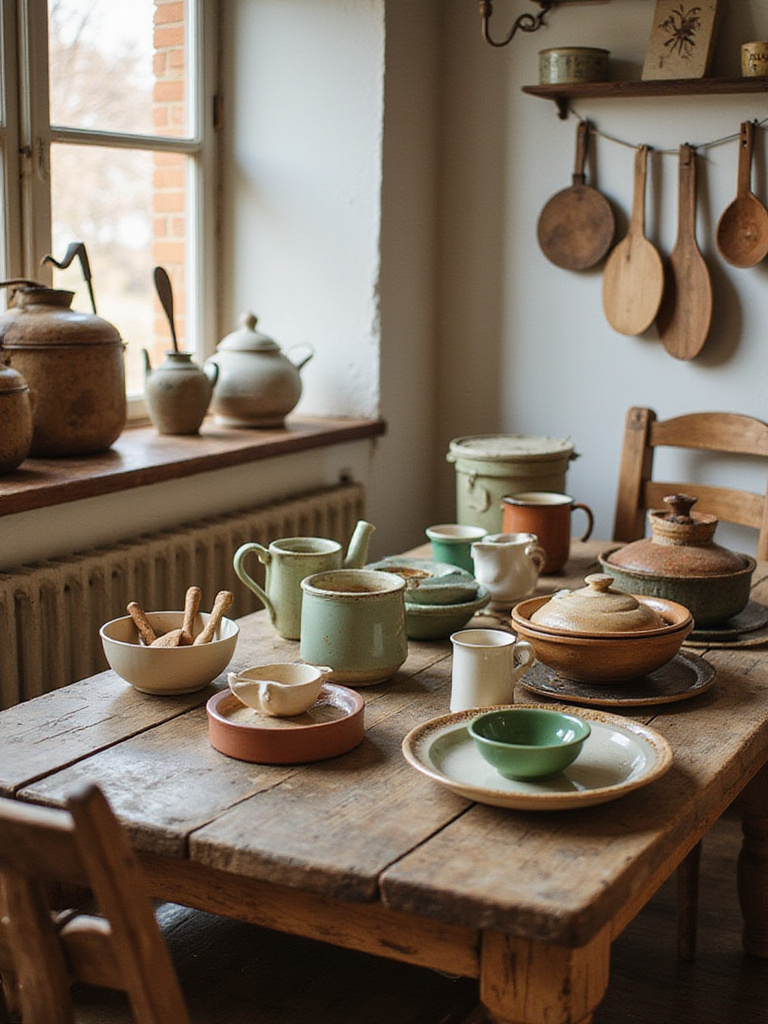
The thrill of discovery at antique shops, estate sales, and flea markets adds personal investment to your farmhouse kitchen decorations, creating collections that reflect your individual taste and patience rather than catalog selections. Each piece carries its own history, whether it’s the gentle wear on a wooden spoon handle or the subtle chips in vintage ironstone that speak of decades of faithful service.
When evaluating potential purchases, look for quality construction, interesting patina, and pieces that will integrate well with your existing collection. Sometimes the most compelling finds are items with minor imperfections that add character rather than detract from functionality – a philosophy that perfectly embodies farmhouse values of finding beauty in imperfection.
What surprises clients most is how these authentic pieces become conversation starters that connect us to previous generations of home cooks.
15. Organize with Woven Baskets and Wooden Crates
Natural storage solutions like woven baskets and wooden crates bring organic texture to farmhouse kitchens while solving practical organization challenges. These pieces soften the hard edges of appliances and cabinetry while providing accessible storage that looks intentional rather than purely functional.
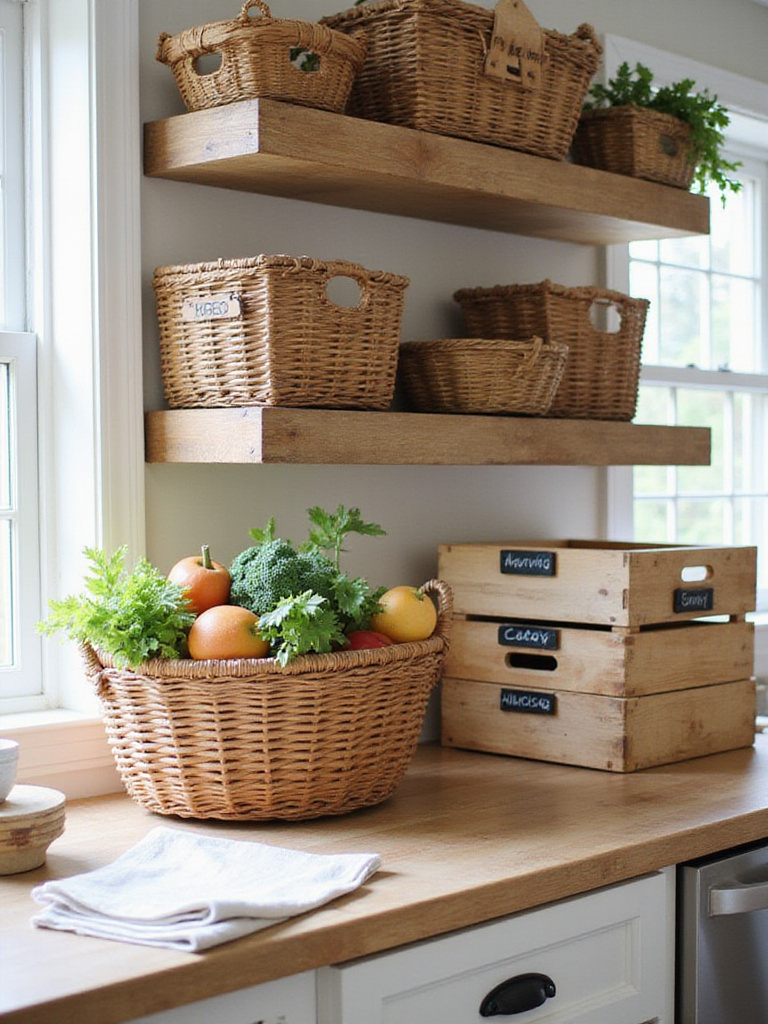
The beauty of natural storage lies in its ability to hide clutter while adding visual interest – produce baskets on counters, storage crates in pantries, and woven bins on open shelves all contribute to the layered, textural quality essential to farmhouse style. Unlike plastic storage solutions, these natural materials age gracefully and develop character through use.
Mix different sizes, materials, and weaving patterns to create visual depth while maintaining organizational efficiency. Label containers with vintage-inspired tags or chalkboard labels to enhance both function and aesthetic appeal, making it easy for family members to maintain the organized systems you create.
The functional evolution story includes how these traditional storage methods have adapted to modern needs while maintaining their timeless appeal.
16. Soften Spaces with Cozy Textiles
Textiles provide essential softness in kitchens dominated by hard surfaces, introducing comfort and warmth through carefully selected rugs, dishtowels, placemats, and window treatments. These elements transform utilitarian spaces into welcoming environments while offering opportunities to introduce subtle color and pattern that enhance the farmhouse aesthetic.
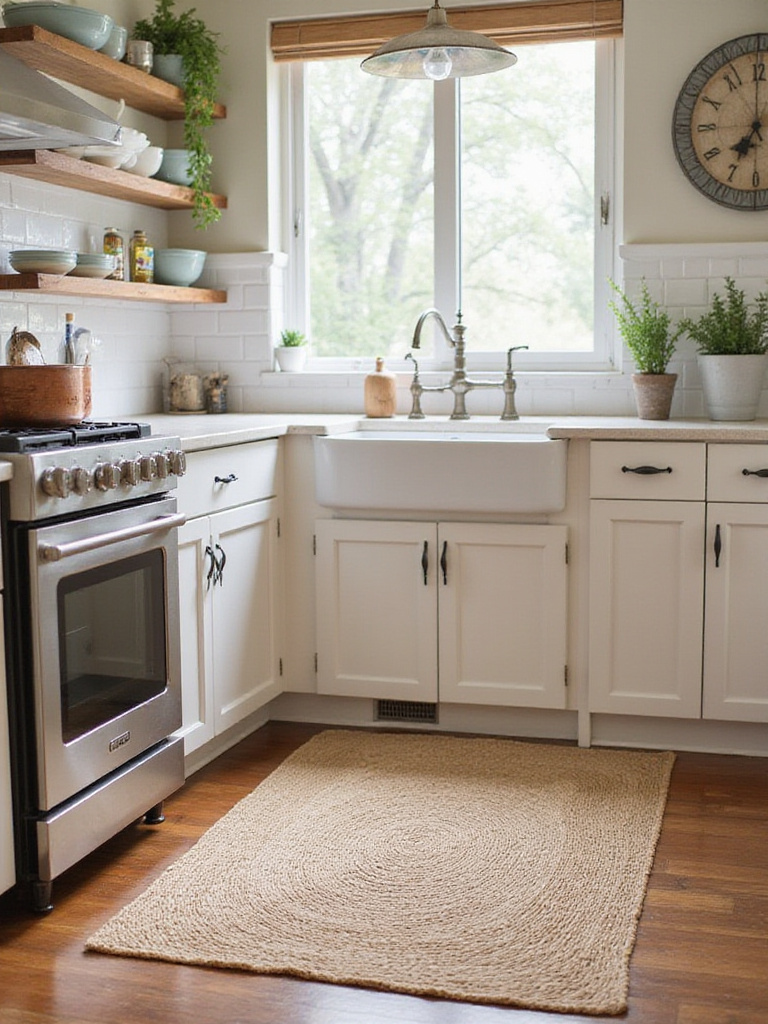
Kitchen rugs deserve special attention for both comfort and style – choose low-pile, washable options in natural fibers like cotton or jute that can withstand spills while providing cushioning for extended standing. Layer different textiles throughout the space, from linen dishtowels draped over oven handles to woven placemats on breakfast bars, creating visual rhythm and tactile interest.
Textile selection for farmhouse kitchen decorations should prioritize:
- Durability: Choose materials that can withstand frequent washing and daily use
- Natural Fibers: Cotton, linen, jute, and wool align with farmhouse values and aesthetic
- Subtle Patterns: Simple stripes, checks, or solid colors that complement rather than compete
The emotional response this evokes begins with the immediate comfort of stepping onto a soft rug after standing on hard flooring.
17. Bring Life with Fresh Greenery & Herbs
Living plants and fresh herbs inject vitality and natural beauty into farmhouse kitchens while providing practical benefits for cooking and air quality. This connection to growing things embodies the farmhouse spirit of self-sufficiency and connection to the land, whether through a windowsill herb garden or strategically placed houseplants that thrive in kitchen conditions.

Edible plants offer dual benefits – fresh basil, rosemary, and thyme provide immediate access to flavor enhancers while contributing natural fragrance and color to your space. Even simple potted herbs in terracotta pots or vintage containers become farmhouse kitchen decorations that serve multiple purposes while requiring minimal maintenance.
For non-edible greenery, choose plants that tolerate kitchen conditions like varying humidity and temperature. Snake plants, pothos, and spider plants all thrive in typical kitchen environments while adding different textures and shades of green that soften hard surfaces and architectural lines.
The discovery of this technique happened when home cooks realized that bringing garden elements indoors created year-round access to fresh ingredients and natural beauty.
18. Hang Rustic Farmhouse Signs for Character
Thoughtfully selected farmhouse signs add personality and visual anchors to kitchen walls while reinforcing the style’s emphasis on meaningful messaging and authentic character. These pieces, whether vintage finds or carefully chosen reproductions, create focal points that communicate values and add warmth to otherwise utilitarian spaces.
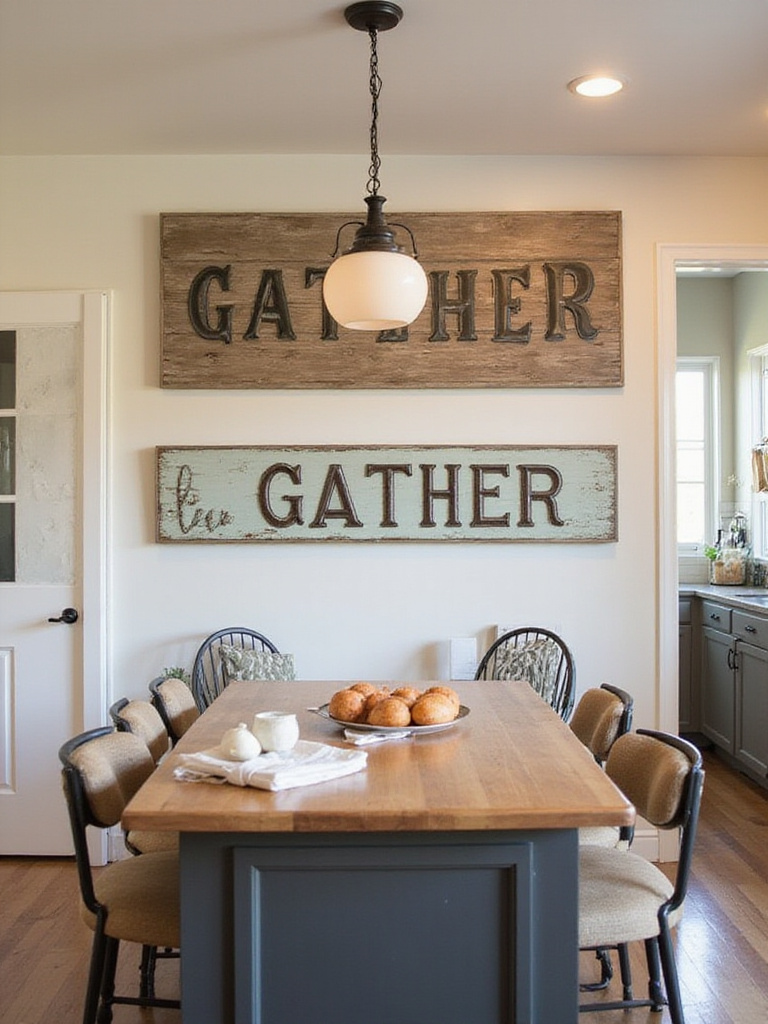
The most effective signs feel personal and authentic rather than generic – family names, meaningful quotes, or local references that reflect your specific story and values. Consider the scale and placement carefully, using larger pieces as statement elements above ranges or dining areas, while smaller signs work well in groupings or tucked into vignettes with other decorative objects.
Mix different materials and styles for authentic variety – distressed wood, galvanized metal, and painted signs each contribute different textures while maintaining overall cohesion through consistent messaging themes or color palettes that complement your existing farmhouse kitchen decorations.
The challenge of awkward spaces becomes easier when you use signs to define and personalize specific zones within larger open-plan areas.
19. Dress Windows with Simple, Natural Treatments
Window treatments in farmhouse kitchens should maximize natural light while providing privacy and style through simple, unfussy designs that complement rather than compete with other design elements. This approach celebrates the connection between indoor and outdoor spaces while maintaining the clean, uncluttered aesthetic essential to farmhouse style.

Natural materials like linen, cotton, or bamboo align with farmhouse values while providing practical benefits like light filtration and easy maintenance. Simple Roman shades, cafe curtains, or even bare windows (where privacy allows) create clean lines that enhance rather than obstruct views and natural light.
Consider the specific needs of each window – cooking areas may require treatments that can handle steam and splashes, while breakfast nook windows might benefit from cafe curtains that provide privacy without blocking morning light. The goal is enhancing function while maintaining the simple beauty that defines farmhouse kitchen decorations.
The styling mistake most people make is choosing treatments that are too heavy or ornate for the casual, relaxed atmosphere that makes farmhouse kitchens so appealing.
20. Combine Mixed Textures for Visual Richness
The final layer that transforms a good farmhouse kitchen into a great one involves thoughtfully combining different textures throughout the space to create visual depth and tactile interest. This technique prevents spaces from feeling flat or one-dimensional while adding the kind of layered complexity that makes rooms feel collected and authentic over time.

Successful texture mixing balances smooth and rough, hard and soft, shiny and matte surfaces throughout the kitchen. Consider how painted cabinets contrast with natural wood counters, how woven baskets soften metal appliances, or how ceramic dishes complement galvanized containers on open shelving. Each material contributes its own character while supporting the overall composition.
The key to mastering texture in farmhouse kitchen decorations lies in distribution and balance – avoid clustering all rough textures in one area or all smooth surfaces in another. Instead, create rhythm through repetition and variation, allowing each texture to enhance rather than compete with its neighbors for a cohesive, inviting result.
The visual weight balances perfectly when you consider both the physical properties of materials and their emotional impact on the space’s overall atmosphere.
Creating Your Dream Farmhouse Kitchen
These 20 essential farmhouse kitchen decorations work together to create spaces that feel both timeless and deeply personal, combining practical function with authentic character. The beauty of this approach lies not in perfection, but in the thoughtful layering of elements that tell your family’s story while honoring the enduring appeal of farmhouse style.
Remember that authentic farmhouse kitchens evolved over time, and yours should too. Start with foundational elements like color palette and key fixtures, then gradually add layers of texture, vintage finds, and personal touches that reflect your unique style and needs. Each addition should feel intentional and meaningful rather than simply decorative.
The most successful farmhouse kitchens balance aspiration with livability, creating spaces beautiful enough for entertaining yet practical enough for daily family life. By focusing on quality materials, timeless designs, and pieces with genuine character, you’ll create a kitchen that serves as the true heart of your home – a place where memories are made, traditions are honored, and the simple pleasure of gathering around good food is celebrated every day.


